Neuroleptic Malignant Syndrome (NMS) isn’t something most people have heard of - until it happens. It doesn’t come with a warning label you can easily spot. One day, someone on antipsychotic medication feels off. Maybe they’re more confused than usual. Their muscles feel locked. Their temperature spikes. By the next day, they’re in intensive care. NMS is rare - affecting fewer than 1 in 1,000 people on these drugs - but when it strikes, it can kill within hours if missed.
What Exactly Is Neuroleptic Malignant Syndrome?
NMS is a severe, life-threatening reaction to medications that block dopamine in the brain. These include older antipsychotics like haloperidol and chlorpromazine, and even some newer ones like risperidone or olanzapine. But it’s not just antipsychotics. Anti-nausea drugs like metoclopramide and promethazine can trigger it too. The core problem? Dopamine stops working where it’s needed - especially in the parts of the brain that control movement, temperature, and alertness.
The body reacts with four key signs, all happening together:
- Severe muscle rigidity - not just stiff, but like concrete. Doctors call it "lead pipe" rigidity because when you try to move the limb, it resists evenly, like bending a lead pipe.
- High fever - usually above 38°C (100.4°F), and often over 40°C (104°F). This isn’t a normal fever from infection. It’s internal heat from muscles locked in constant contraction.
- Changed mental state - confusion, agitation, mutism, or even coma. The person might stare blankly, not respond, or seem terrified.
- Autonomic chaos - heart racing (over 90 bpm), blood pressure swinging up and down, sweating profusely, rapid breathing.
These symptoms usually show up within two weeks of starting or increasing a medication. Sometimes, they appear in just 48 hours. Rarely, they show up months later. The trigger isn’t always obvious. Even a small dose increase - like adding 5 mg of haloperidol - can be enough.
Why Is NMS So Dangerous?
It’s not just the fever or the rigidity. The real danger is what happens inside the muscles. When muscles stay locked for hours, they start breaking down. This releases a protein called myoglobin into the bloodstream. Myoglobin clogs the kidneys. About 30% of people with NMS develop acute kidney failure. Some need dialysis.
Lab tests show this clearly. Creatine kinase (CK) levels - a marker of muscle damage - often spike above 1,000 IU/L. In severe cases, they hit 100,000 IU/L. White blood cell counts rise. Blood becomes acidic. Iron levels drop. All of this is a sign the body is under extreme stress.
Without treatment, 10-20% of people die. Even with treatment, 5% don’t survive. The biggest killer? Delay. If doctors mistake NMS for worsening psychosis or an infection, the window to act closes fast. Studies show up to 12% of cases are misdiagnosed at first. One patient on Reddit said it took 48 hours for staff to realize their schizophrenia wasn’t getting worse - their body was shutting down.
NMS vs. Serotonin Syndrome vs. Malignant Hyperthermia
Doctors often confuse NMS with two other emergencies. But they’re different.
Serotonin syndrome comes from too much serotonin - usually from combining antidepressants. It hits fast: within hours. Symptoms include tremors, clonus (involuntary muscle jerking), diarrhea, and hyperreflexia. Muscle rigidity? Less common. And it doesn’t usually cause the same level of temperature spike or CK elevation as NMS.
Malignant hyperthermia happens during anesthesia. It’s triggered by certain gases or muscle relaxants. It starts in minutes, not days. You see jaw spasms, rapid breathing, and dark urine. It’s genetic. NMS isn’t. But both can be treated with dantrolene - a muscle relaxant that stops the breakdown.
Here’s the key difference: NMS is slow, stiff, and silent. Serotonin syndrome is jittery and loud. Malignant hyperthermia is sudden and surgical. Mixing them up can cost lives.
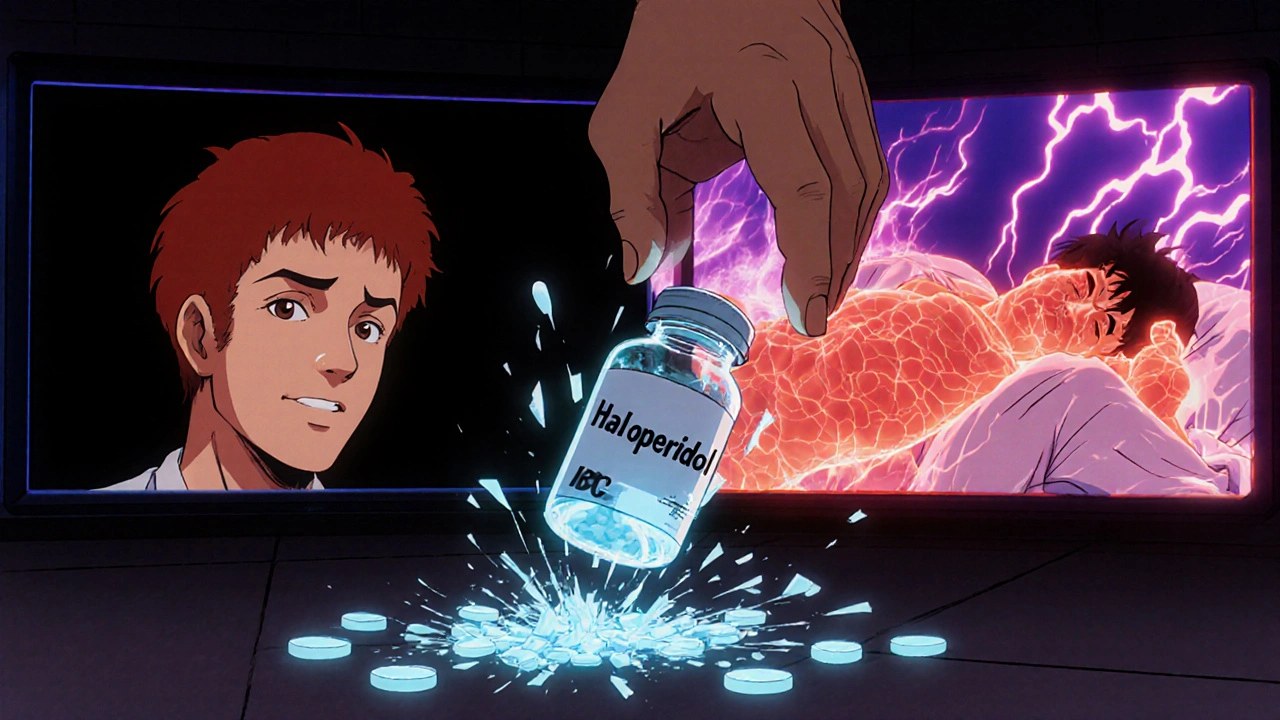
Who’s at Risk?
It’s not random. Certain factors raise the risk:
- Using older antipsychotics (first-generation) like haloperidol or fluphenazine
- Rapidly increasing the dose - especially by more than 5 mg/day of haloperidol
- Injecting antipsychotics instead of taking pills
- Taking lithium with antipsychotics
- Being young and male - men are twice as likely to develop NMS
- Having bipolar disorder, not schizophrenia
- Stopping Parkinson’s meds suddenly - about 5% of cases happen this way
Most cases - 60% - happen when someone first starts the medication. Another 30% happen when the dose goes up. Only 10% occur in people who’ve been stable on the drug for months or years.
What Happens When NMS Is Suspected?
If NMS is suspected, time is everything. There’s no single blood test to confirm it. Diagnosis is clinical - based on symptoms and timing. The moment NMS is suspected, four things must happen immediately:
- Stop the medication. All antipsychotics, anti-nausea drugs, or anything blocking dopamine - gone. No exceptions.
- Get to the ICU. This isn’t a hospital ward case. This needs constant monitoring of heart rate, blood pressure, temperature, and kidney function.
- Cool the body. Ice packs, cooling blankets, IV fluids. Don’t wait for the fever to hit 104°F. Start cooling as soon as it’s above 38.9°C.
- Hydrate aggressively. At least 1-2 liters of IV fluids right away, then 100-150 mL per hour. This flushes out muscle breakdown products and protects the kidneys.
Doctors may also give:
- Dantrolene - 1-2.5 mg/kg IV, repeated up to 10 mg/kg if needed. It relaxes muscles and stops the breakdown.
- Bromocriptine - 2.5-10 mg by mouth every 8 hours. It tricks the brain into thinking dopamine is still active.
- Amantadine - sometimes used as an alternative to bromocriptine.
CK levels are checked every 6-12 hours. They peak around 72-96 hours after onset. If they keep rising, the muscle damage is still spreading. If they drop fast, recovery is likely.
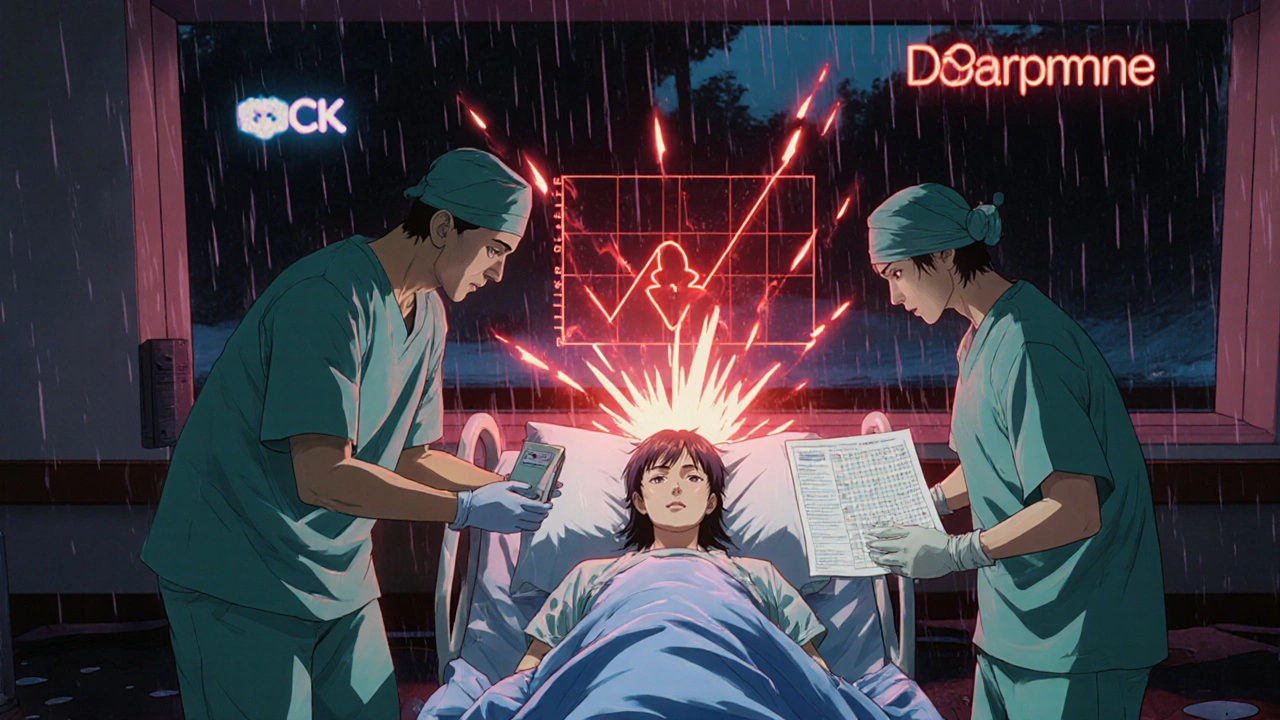
Recovery and Long-Term Effects
If caught early, most people recover in 7-10 days. But recovery isn’t simple. Muscle weakness can linger. One patient on Schizophrenia.com said it took eight weeks before they could walk without help. About 15% of survivors still have muscle problems 30 days later.
Many people are terrified to take antipsychotics again. A 2022 survey found 65% of NMS survivors refused to restart medication - even if their psychosis returned. That’s a huge problem. Stopping treatment can lead to relapse, hospitalization, or worse.
When restarting antipsychotics, doctors go slow. They pick one with lower NMS risk - like quetiapine or clozapine. They start with a tiny dose and increase over weeks. Some use dantrolene as a precaution during the first few days. No guarantees, but it’s safer than waiting for another crisis.
What’s New in NMS Research?
There’s progress. In 2023, the FDA updated black box warnings on all antipsychotics to say NMS can happen even with "therapeutic" doses and no known risk factors. About 12% of cases occur this way - no warning, no explanation.
Some hospitals are testing AI tools that scan electronic records for early signs - like rising CK, fever, or sudden immobility - and flag them 24 hours before a doctor would notice. Early results show 85% accuracy.
A clinical trial at the Cleveland Clinic is testing intranasal apomorphine - a dopamine activator - delivered through the nose. In early tests, it brought down fever in 70% of patients within 4 hours. That’s faster than IV bromocriptine.
Future drugs may target dopamine receptors more precisely, avoiding the areas that cause rigidity and heat. If successful, NMS could become almost unheard of within a decade.
What Should You Do?
If you or someone you care for is on antipsychotics or anti-nausea meds and suddenly develops:
- Stiff muscles that won’t move
- Fever above 38°C
- Confusion, mutism, or unresponsiveness
- Rapid heartbeat or sweating
- call emergency services immediately. Don’t wait. Don’t assume it’s "just anxiety" or "worse psychosis." NMS doesn’t wait.
Keep a list of all medications - including over-the-counter ones - and share it with every doctor. If you’ve had NMS before, wear a medical alert bracelet. Tell your psychiatrist before any new drug is added.
It’s rare. But when it hits, it hits hard. Knowing the signs could save a life - even your own.
Can NMS happen with newer antipsychotics like risperidone or olanzapine?
Yes. While first-generation antipsychotics like haloperidol carry the highest risk, second-generation drugs like risperidone, olanzapine, and even clozapine can still trigger NMS. The risk is much lower - about 0.01% to 0.02% - but it’s not zero. Cases have been documented with all of them, especially when doses are increased quickly or given by injection.
Is NMS the same as a psychotic breakdown?
No. While both can involve confusion or mutism, NMS is a physical emergency. In psychosis, muscles are relaxed. Temperature is normal. Heart rate is steady. In NMS, the body is in crisis: muscles are locked, temperature is dangerously high, and vital signs are chaotic. Mistaking NMS for worsening psychosis delays treatment - and increases the chance of death.
Can you get NMS from stopping antipsychotics too fast?
Not directly. But if you’re on dopamine-blocking drugs for Parkinson’s - like levodopa - and you stop them suddenly, you can develop a similar condition called dopamine withdrawal syndrome. It mimics NMS with rigidity, fever, and confusion. It’s rare, but it happens. Always taper Parkinson’s meds under doctor supervision.
How long does it take to recover from NMS?
Most people start improving within 3-7 days after stopping the medication and getting treatment. Full recovery usually takes 7-10 days. But muscle damage can linger. Some people take weeks or months to regain full strength. About 15% still have weakness at 30 days. Kidney function usually returns to normal if treated early.
Can NMS come back if you take antipsychotics again?
Yes. If you’ve had NMS once, you’re at higher risk if you take any dopamine-blocking drug again. But it’s not guaranteed. Some people safely restart antipsychotics under close supervision - using low-risk drugs like quetiapine, starting with tiny doses, and monitoring closely. Some doctors even use dantrolene as a preventive during the first few days of restarting. Never restart without consulting a specialist.
Are there any home remedies or supplements that help with NMS?
No. NMS is a medical emergency that requires ICU-level care. Home remedies, herbs, or supplements won’t help - and could delay life-saving treatment. Cooling the body with ice packs is only a temporary measure while waiting for emergency services. The only effective treatments are stopping the drug, IV fluids, dantrolene, and intensive monitoring.





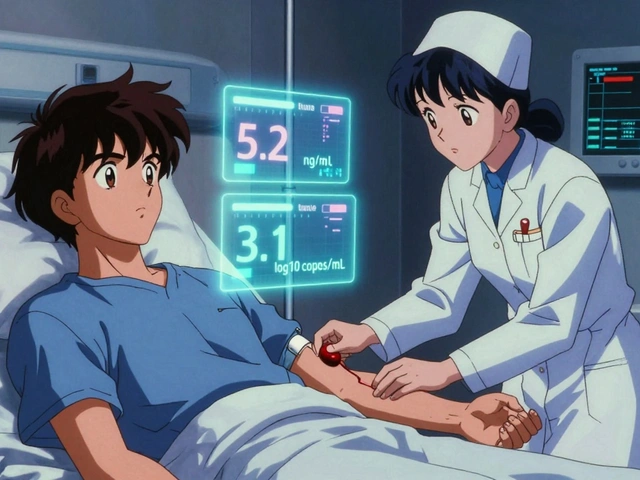
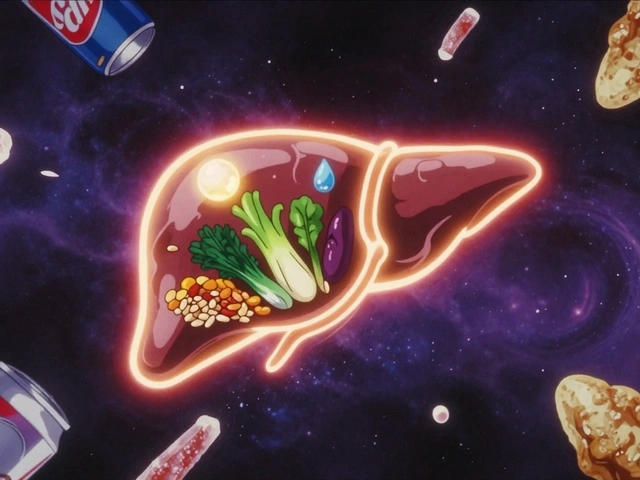
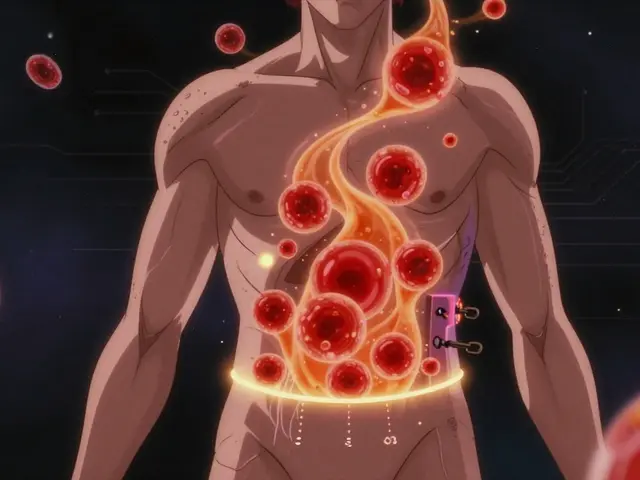
14 Comments
Jonah Thunderbolt
Nov 28 2025I mean, honestly, this is just the tip of the iceberg. Like, we’ve known dopamine blockade = muscle rigidity since the 60s, but hospitals still treat it like it’s ‘maybe psychosis’? 🤦♂️ I’ve seen it firsthand-my cousin got misdiagnosed for 36 hours. By then, his CK was at 89,000. They had to dialyze him. The system is broken. 😭
Leo Adi
Nov 28 2025In India, we don’t even have proper ICU access in most towns. If someone gets NMS in a rural hospital, it’s basically a death sentence. We need awareness, not just fancy AI flags. 🙏
Melania Rubio Moreno
Nov 30 2025ok but like… why do we even still use these drugs if they can just… melt your body??
Gaurav Sharma
Dec 1 2025The medical community’s failure to recognize NMS as a distinct entity reflects a systemic epistemological deficit in psychiatric training. This is not negligence; it is ontological ignorance.
Shubham Semwal
Dec 3 2025Bro, I used to work in psych ward. Saw a dude turn into a statue after a haloperidol shot. Staff thought he was just being ‘resistant’. Took 2 days to figure it out. He almost died. People are idiots.
Sam HardcastleJIV
Dec 3 2025One cannot help but observe that the proliferation of antipsychotic pharmacology has outpaced the development of clinical vigilance. This is not a failure of medicine, but of civilizational priorities.
Mira Adam
Dec 4 2025This is why I don’t trust psychiatry. You give someone a pill that turns them into a living corpse and then act like it’s ‘just part of the process’. You’re all complicit.
Miriam Lohrum
Dec 5 2025It’s fascinating how the body responds to chemical disruption with such physical extremity. The mind and body aren’t separate-they’re a single system. NMS proves that. We treat mental illness like it’s a software glitch, but it’s more like a nuclear reactor overheating.
archana das
Dec 5 2025My uncle had this. He was on haloperidol for bipolar. One morning he couldn’t stand. Fever. No talking. We rushed him. They saved him. Now he takes quetiapine. Small dose. Slow. He’s fine. Don’t wait. Act fast. Love you all.
Rhiana Grob
Dec 6 2025Thank you for writing this with such clarity. Families need this information. I’ve seen too many people dismissed as ‘just acting out’. This could prevent so much suffering. Please share this with every ER, every clinic, every school nurse.
Frances Melendez
Dec 7 2025People on these meds are just asking for it. If you can’t handle the side effects, don’t take them. You think the world owes you a mental health pass? Wake up.
Asha Jijen
Dec 7 2025i think they should just stop giving antipsychotics to everyone and let people be weird without drugging them
Kaleigh Scroger
Dec 7 2025The key thing no one talks about is that NMS isn’t just about the drug-it’s about the lack of monitoring. Inpatient units have nurses checking vitals every 4 hours. Outpatient? You get a script and a prayer. We need mandatory CK baseline testing before starting any dopamine blocker. And mandatory 72-hour follow-up. No exceptions. This isn’t optional safety-it’s standard of care. And if you’re not doing it, you’re not a doctor-you’re a risk taker.
Elizabeth Choi
Dec 8 2025The fact that 12% of NMS cases occur without any identifiable risk factors undermines the entire predictive model of pharmacovigilance. This suggests either a profound lack of understanding of the underlying pathophysiology or systemic underreporting. Either way, the current framework is inadequate.